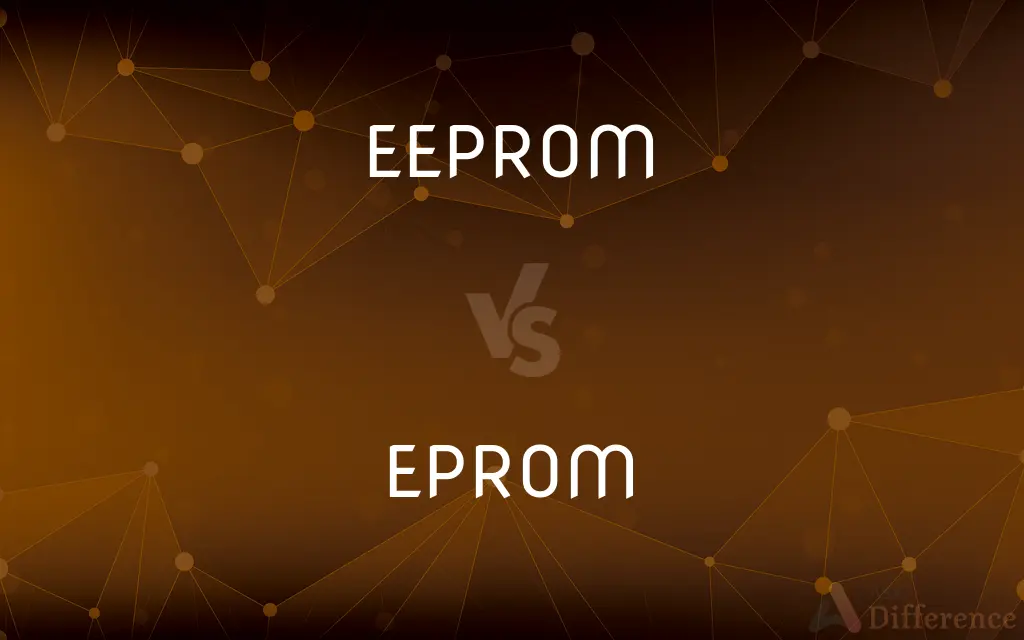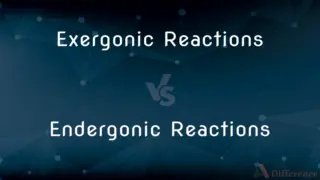EEPROM vs. EPROM — What's the Difference?
Edited by Tayyaba Rehman — By Fiza Rafique — Published on December 10, 2023
EEPROM is an electrically Erasable Programmable Read-Only Memory, erased & programmed electronically. EPROM is an erasable Programmable Read-Only Memory, erased using ultraviolet light.

Difference Between EEPROM and EPROM
Table of Contents
ADVERTISEMENT
Key Differences
EEPROM and EPROM are both types of non-volatile memory used in computers and electronic devices to retain data. The primary distinction between EEPROM and EPROM lies in the erasure mechanism. While EEPROM can be erased and reprogrammed electronically, EPROM requires ultraviolet (UV) light for erasure.
In terms of usability, EEPROM is more versatile than EPROM. Because EEPROM can be programmed and erased while in the device, it allows for more dynamic updates. EPROM, on the other hand, requires removal from the device for erasure, making it less flexible for in-system alterations.
EEPROM's electronic erasure advantage means it can be erased at the byte level, allowing for selective data changes. In contrast, EPROM erasure is an all-or-nothing proposition, with the entire chip getting erased when exposed to UV light.
However, EPROM tends to have a longer data retention ability compared to EEPROM. Over time and multiple erase/write cycles, the EEPROM may wear out faster than EPROM.
Lastly, from a physical standpoint, EPROM chips can often be recognized by a transparent window on the top, which allows the UV light to penetrate and erase the data. EEPROM chips lack this window, as they're erased electronically.
ADVERTISEMENT
Comparison Chart
Erasure Mechanism
Electronically
Ultraviolet light
In-system Alterations
Can be reprogrammed while in the device
Needs removal from device for erasure
Erasure Level
Byte-level (selective data changes possible)
Entire chip (non-selective)
Data Retention
Can wear out faster with multiple erase/write cycles
Longer retention compared to EEPROM
Physical Identifier
No specific physical feature
Transparent window on top for UV light penetration
Compare with Definitions
EEPROM
A type of non-volatile memory that can be electronically erased.
The device uses EEPROM to store configuration settings.
EPROM
Recognizable by its transparent window for UV light penetration.
The transparent window on the EPROM chip allows for data erasure.
EEPROM
Typically has faster erase and write times than EPROM.
Manufacturers prefer EEPROM for dynamic data storage due to its speed.
EPROM
Once programmed, it retains data indefinitely until erased.
Our old computer's firmware is stored on an EPROM.
EEPROM
Memory that allows byte-level erasure and reprogramming.
Byte-level flexibility of EEPROM aids in selective data updates.
EPROM
Non-volatile memory that uses UV light for data erasure.
The EPROM chip retains data unless exposed to UV light.
EEPROM
Doesn't require a physical UV light exposure for erasure.
The advantage of EEPROM is its electronic erasure mechanism.
EPROM
Not as versatile as EEPROM for in-system reprogramming.
Due to its UV erasure method, EPROM isn't ideal for frequent updates.
EEPROM
Can wear out after a certain number of erase/write cycles.
The device's EEPROM may need replacement after extensive use.
EPROM
Offers robust data retention over long periods.
The data stored on EPROM is safe for many years.
EPROM
A programmable ROM that can be erased by exposure to ultraviolet light and then reprogrammed.
EPROM
(computer science) a read-only memory chip that can be erased by ultraviolet light and programmed again with new data
Common Curiosities
Can EEPROM be reprogrammed without removing it from a device?
Yes, EEPROM can be reprogrammed while still in the device.
What is the unique physical feature of an EPROM chip?
EPROM chips have a transparent window on top for UV light exposure.
Is the entire EPROM chip erased at once or selectively?
The entire EPROM chip is erased at once when exposed to UV light.
How can data be retained indefinitely on EPROM?
EPROM retains data indefinitely until it's exposed to UV light for erasure.
Which memory type is typically recognized by a transparent window?
EPROM chips are recognized by a transparent window for UV light exposure.
Are there any physical identifiers on EEPROM chips like EPROM?
No, EEPROM chips lack the transparent window that EPROM chips have.
What type of memory are both EEPROM and EPROM?
Both EEPROM and EPROM are types of non-volatile memory.
Which memory type can wear out faster with multiple erase/write cycles?
EEPROM can wear out faster with multiple erase/write cycles.
How is EEPROM data typically erased?
EEPROM data is erased electronically.
Which memory type allows for selective data changes?
EEPROM allows for selective data changes at the byte level.
Can EPROM be reprogrammed electronically like EEPROM?
No, EPROM requires UV light exposure for erasure before reprogramming.
Why might manufacturers choose EEPROM over EPROM for some applications?
EEPROM's electronic reprogramming and byte-level erasure make it more versatile for dynamic data storage.
Do both EEPROM and EPROM need power to retain data?
No, both EEPROM and EPROM retain data without power, making them non-volatile.
Between EEPROM and EPROM, which is more suited for frequent in-system updates?
EEPROM is more suited for frequent in-system updates due to its electronic erasure and reprogramming capability.
Is the erasure of EEPROM faster than EPROM?
Yes, EEPROM typically has faster erase times compared to EPROM.
Share Your Discovery

Previous Comparison
Inert Gases vs. Noble Gases
Next Comparison
Exergonic Reactions vs. Endergonic ReactionsAuthor Spotlight
Written by
Fiza RafiqueFiza Rafique is a skilled content writer at AskDifference.com, where she meticulously refines and enhances written pieces. Drawing from her vast editorial expertise, Fiza ensures clarity, accuracy, and precision in every article. Passionate about language, she continually seeks to elevate the quality of content for readers worldwide.
Edited by
Tayyaba RehmanTayyaba Rehman is a distinguished writer, currently serving as a primary contributor to askdifference.com. As a researcher in semantics and etymology, Tayyaba's passion for the complexity of languages and their distinctions has found a perfect home on the platform. Tayyaba delves into the intricacies of language, distinguishing between commonly confused words and phrases, thereby providing clarity for readers worldwide.














































